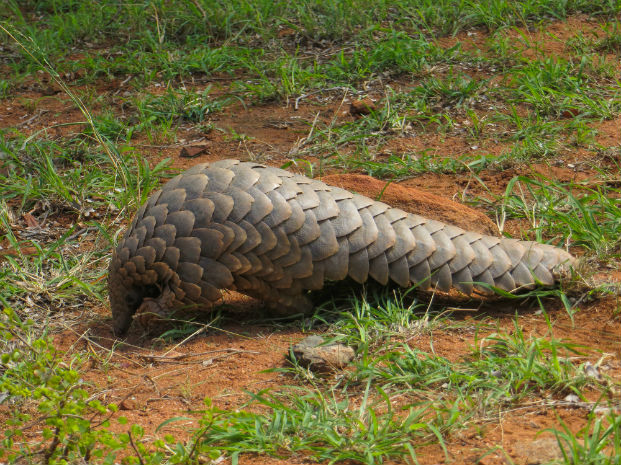The third Saturday in February each year is World Pangolin Day. But despite having their own dedicated day in the international calendar not many could identify the weird looking animal.
Before I launch into the detail about this amazing and fascinating creature the most important thing to know is that the pangolin is the world’s most poached animal. There are eight species in all, four in Asia and four in Africa. This worldwide population has come under increased pressure due to poaching for food and use in traditional medicine. In fact almost one million pangolins have been poached from the wild in the last ten years.
Discover further facts, photos and video about the African ground pangolin on our Pangolin Profile.
The weird but very cool looking pangolin is covered in scales. But despite all the scales that make up 20% of its body weight it is not a reptile but a mammal. These scales are made of keratin, the same protein substance which makes up our hair and nails, and of course rhino horn. There is no scientifically proven benefit of keratin as a medicine.
The ground pangolin (Smutsia temminckii) featured on Fascinating Africa is classed by the IUCN as vulnerable. It measures 90 cm (including a tail of up to 40 cm) and weighs between 5 and 18 kg. Here’s everything you need to know about the pangolin.
Read about safari guide, Jomi Krobb’s, experience of seeing a pangolin for the first time in this Fascinating Africa blog post.
Feeding
- These solitary animals are active at night when they hunt for their insect prey which they locate using an acute sense of smell.
- A pangolin will use its 4.5 cm claws to open up termite and ant nests as well as for pulling bark off trees as it searches for insects.
- When feeding the ground pangolin is able to close its nostrils and ears to keep insects out. Its eye lids are thick to protect their eyes from ant bites.
- A pangolins tongue can extend 10 to 15 cm beyond its lips. It starts deep in the chest cavity where it is attached to the lowest part of the breast bone. This means that when it is not in use it can be drawn back in to a cartilaginous structure where it is out of the way.
- Pangolins have enlarged salivary glands which are positioned on each side of its head and extend back towards the shoulders. A large quantity of saliva is required to aid digestion and so that the insects sticks to its tongue.
- As a pangolin feeds it laps up insects with its saliva covered tongue. Each time it brings the tongue back into its mouth the insects are scraped off by a bony projection and swallowed.
- 90% of a ground pangolin’s diet is made up of ants with the remainder being termites. In one year it may eat 70 million insects.
The African pangolin in the BBC’s Life of Mammals series. In this clip, pangolins raid a massive ants’ nest.
Source: BBC Earth
Locomotion
- A pangolin will walk on its hind legs using its front legs and tail as a counter balance.
- A pangolin does not have teeth. Instead its insect prey is ground up in its muscular stomach with the help of sand and soil which it is inadvertently ingested as it feeds.
Reproduction
- It is believed that a ground pangolin only becomes sexually mature at 5 to 7 years old.
- The pangolin has one pup a year. The baby will ride on its mother at the base of her tail.
- After 4.5 months gestation the baby pangolin’s scales are soft but soon harden.
- The life span was believed to be ten years. However, recent research suggests that it may be as much as 20 years.
Defence
- The word pangolin originates from the Malay word “pengguling”, which means “something that rolls up”. This is in reference to how the pangolin will roll itself up into a tight ball, sealing itself with its muscular tail for defence.
- If a pangolin is captured it will thrash its scale covered tail. The tails have sharp edges which can inflict nasty cuts. It is also able to release a foul smelling fluid from its anal glands.
Threats
- The hunting of pangolins for bush meat and traditional medicines is the key threat to the species in Africa:
- Some tribes in east Africa believe that all the body parts of a ground pangolin have healing properties. As a result they refer to the mammal as Bwana Mgana, meaning “Mr Doctor”.
- In east Africa it is believed that burning the scales of a ground pangolin will keep lions away.
- Habitat loss, pesticides and the installation of electric fences are a secondary threat to the four species of pangolin in Africa.
- Disturbingly the African pangolins are now being targeted for the illegal wildlife trade to Asian markets as a delicacy in some Chinese and Vietnamese cultures. The scales are also being used in traditional medicines.
Get involved
What can you do to help the pangolin?
Vote for your favourite pangolin fact
How can you have some fun on World Pangolin Day?


 Previous Post
Previous Post
